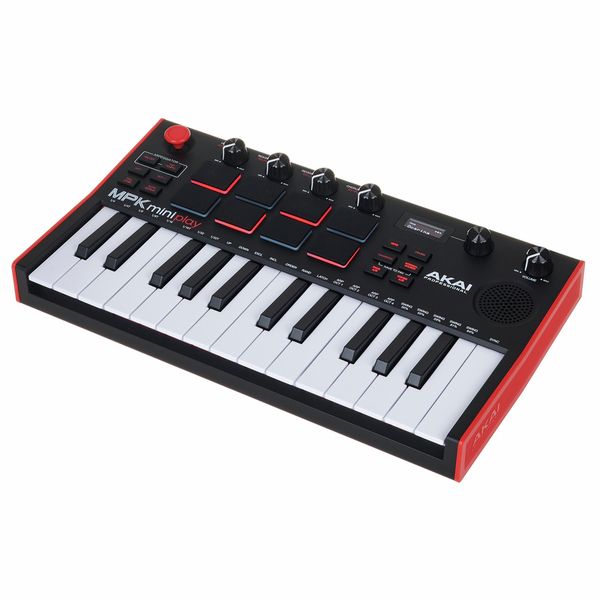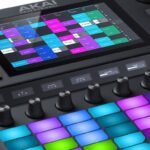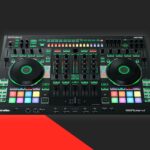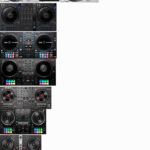Comprehensive comparison of all three Akai MPK Mini models: Mark III, Play, and Plus. Expert analysis of features, connectivity, built-in sounds, sequencer, and which model best fits your music production needs.
Akai MPK Mini Plus vs. MPK Mini Play vs. MPK Mini Mk3: Complete Comparison Guide
Introduction: The Complete MPK Mini Lineup
With the recent release of the MPK Mini Plus, Akai has rounded out their MPK Mini lineup in impressive fashion. Three distinct models now serve different producer needs across the entry-level to intermediate MIDI keyboard spectrum. Each keyboard offers unique features at accessible price points, creating options for various production styles and workflows.
This comprehensive comparison examines the MPK Mini Mark III, MPK Mini Play, and MPK Mini Plus to help you select the perfect MPK Mini for your specific requirements.
MPK Mini Mark III: The Essential Foundation
Core Specifications
The MPK Mini Mark III ($99 retail) represents the baseline MPK Mini experience—covering all essential MIDI keyboard functions without extra bells and whistles.
Keybed: Gen 2 Enhanced
25 mini keys featuring Akai’s updated Gen 2 Enhanced Dynamic Keybed:
- Significantly improved feel over Mark II predecessor
- Excellent velocity response capturing playing dynamics
- Comfortable for extended sessions
- Solid, reliable construction
This keybed upgrade addressed the primary complaint about previous MPK Minis, bringing playing experience to competitive standards.
Drum Pads: MPC Heritage
Eight velocity-sensitive drum pads with A/B pad banking (16 total):
- Iconic MPC-style pad feel
- Superior size compared to many competitors
- Excellent velocity sensitivity
- Red backlight illumination
The pad quality and layout excel for finger drumming and beat programming—a signature MPK Mini strength.
Additional Features
- Octave controls for range extension
- Note repeat function for rapid drum programming
- Built-in arpeggiator with customizable parameters
- Eight rotary knobs (endless encoders)
- Four-way joystick for pitch and modulation
- Small OLED display for parameter feedback
Ideal Users
The Mark III suits:
- Producers seeking affordable, capable MIDI keyboard
- Users requiring only essential MIDI controller features
- Budget-conscious musicians maximizing value
- Supplementary controller for existing setups
Bottom Line: If you need a reliable MIDI keyboard covering all basics without unnecessary extras, the Mark III delivers exceptional value at $99.
MPK Mini Play: Standalone Creativity
Enhanced Specifications
The MPK Mini Play ($149 retail) includes practically identical features as the Mark III plus over 100 built-in sounds enabling standalone operation.
Dual Functionality
MIDI Controller Mode: Functions identically to MPK Mini Mark III when connected to DAW.
Standalone Mode: Operates independently using internal sounds through built-in speaker.
Built-In Sound Library
Drum Kits
Ten different drum kits accessible via dedicated menu:
- Electronic kits
- Acoustic kits
- Hybrid percussion
- Sound effect collections
The variety enables complete beat programming using only internal sounds.
Melodic Instruments
128 different key presets spanning multiple categories:
- Synthesizers (analog and digital flavors)
- Bass sounds (electric and synth bass)
- Keyboard instruments (pianos, organs, electric pianos)
- Sound effects and atmospheric textures
Sound Control
Four physical knobs expand to eight total parameters via A/B knob banking:
- Attack envelope shaping
- Release envelope shaping
- EQ for tonal adjustment
- Filter cutoff frequency
- Resonance for filter emphasis
- Reverb mix for spatial effects
- Chorus mix for width and movement
- Additional modulation parameters
These controls enable real-time sound shaping of internal presets, creating performance dynamics and customized tones.
Built-In Speaker
The small internal speaker enables:
- Practice without external monitoring
- Casual playing and experimentation
- Portable jam sessions
- Sound preview without headphones
While not suitable for serious production monitoring, the speaker serves its intended purpose well.
Compact Design Note
The Play version features slightly smaller drum pads compared to Mark III. However, functionality remains excellent, with the size reduction enabling internal sound electronics integration.
Value Proposition
At $149, the Play costs $50 more than the Mark III. The value equation depends on whether standalone functionality and built-in sounds serve your workflow. For producers frequently away from their main setup or those desiring creative experimentation without computer dependency, the added features justify the premium.
Complete Song Demonstration
The Play’s internal sounds prove surprisingly capable—entire productions can be created using only this keyboard. The sound quality and variety enable legitimate music creation, not merely sketching ideas.
MPK Mini Plus: Professional Expansion
Advanced Specifications
The MPK Mini Plus ($169 retail) represents Akai’s most feature-rich mini keyboard, expanding beyond the Mark III and Play with professional capabilities.
Expanded Keyboard: 37 Keys
37 mini keys rather than 25:
- Extended range reducing octave-switching frequency
- Same excellent Gen 2 keybed feel
- Comfortable playing experience across broader range
- Ideal balance between portability and playability
The additional octave makes significant practical difference in workflow, especially for more complex musical passages.
Enhanced Drum Pads
Eight MPC-style pads with upgraded features:
- RGB backlighting with per-pad color customization
- Colors change based on selected program
- Pad bank function (16 total pads accessible)
- Velocity-sensitive with excellent dynamics
The RGB implementation serves functional purposes beyond aesthetics—visual feedback for different programs and assignments aids workflow.
Improved Display
The OLED screen functionality improves over Mark III:
- Context-sensitive display showing only relevant parameters
- Clearer readouts for individual functions
- Better organization reducing visual clutter
When using the arpeggiator, for example, the screen changes based on which parameter you’re adjusting rather than displaying everything simultaneously.
Traditional Pitch and Mod Wheels
In addition to the joystick, the Plus includes dedicated pitch and modulation wheels:
- Smooth modulation wheel action
- Spring-loaded pitch wheel with appropriate resistance
- Plastic construction but adequate quality
- Traditional wheel feel preferred by many players
This dual approach (joystick plus wheels) provides flexibility for different performance techniques.
Innovative Features
Chord Mode
The Chords feature simplifies harmonic playing:
- Select chord type: Triads, seventh chords, extended harmony
- Choose key and scale: Automatic appropriate chord selection
- Play single keys: Each key triggers complete chord
- Inversions available: Ascending keyboard triggers different voicings
This feature benefits producers less fluent in keyboard harmony, enabling sophisticated chord progressions with simplified input.
Scale Mode
Scale constraints prevent “wrong notes”:
- Select key and scale: C Major, D Dorian, etc.
- Play any keys: Notes automatically snap to scale
- Experimentation encouraged: Can’t play “wrong” notes
Playing all black keys, for instance, automatically adjusts those pitches to fit the selected scale. This removes harmonic concerns during creative flow.
Transport Controls
Dedicated DAW transport buttons (bottom right):
- Play
- Stop
- Record
- Cycle/Loop toggle
Hands-free transport control eliminates mouse dependency for common recording operations—a highly requested feature finally delivered.
Built-In Sequencer: Game Changer
Perhaps the Plus’s most exciting addition: hardware sequencer capability.
Step Edit Mode
Manually input notes step-by-step, building patterns without real-time performance.
Live Sequence Mode
Record performances in real-time, capturing playing nuances and timing.
Practical Sequencing
The sequencer handles complex pattern creation, loop building, and multi-track arrangement directly on the controller. This capability opens entirely new workflows, especially for hardware-based production.
Expanded Connectivity
The Plus features CV (Control Voltage) and Gate outputs plus MIDI I/O:
- Control hardware synthesizers
- Trigger modular synthesis systems
- Sequence hardware drum machines
- Build hardware-based production setups
This connectivity future-proofs the Plus for producers expanding into hardware gear. The ability to sequence multiple hardware devices from one controller creates powerful possibilities.
Value Analysis
At $169, the Plus costs only $20 more than the Play yet offers substantially more functionality. For anyone interested in hardware integration or requiring extended key range, the Plus represents exceptional value.
The Plus particularly suits producers who:
- Want 37-key compact MIDI keyboard
- Plan to use hardware synthesizers or drum machines
- Need built-in sequencer for hardware workflow
- Desire room to grow as production skills develop
Direct Feature Comparison
| Feature | Mark III | Play | Plus |
|---|---|---|---|
| Keys | 25 | 25 | 37 |
| Price | $99 | $149 | $169 |
| Drum Pads | 8 (Red LED) | 8 (smaller) | 8 (RGB) |
| Built-in Sounds | No | Yes (100+) | No |
| Sequencer | No | No | Yes |
| MIDI I/O | No | No | Yes |
| CV/Gate | No | No | Yes |
| Pitch/Mod | Joystick only | Joystick only | Joystick + Wheels |
| Transport Controls | No | No | Yes |
| Chord Mode | No | No | Yes |
| Scale Mode | No | No | Yes |
Which MPK Mini Should You Choose?
Choose MPK Mini Mark III If:
- Budget is primary concern — Best value for essential features
- Basic MIDI control sufficient — No need for extras
- Supplementary controller — Adding to existing setup
- Portability paramount — Smallest, lightest option
Choose MPK Mini Play If:
- Standalone operation important — Practice without computer
- Built-in sounds valuable — Want complete creative tool
- Portable inspiration — Create anywhere with internal speaker
- Mark III insufficient — Need more than basic MIDI
Choose MPK Mini Plus If:
- 37 keys preferred — Extended range reduces octave switching
- Hardware integration planned — MIDI I/O and CV/Gate essential
- Sequencer workflow appeals — Hardware-based production interests you
- Maximum features desired — Want most capable MPK Mini
- Future-proofing important — Room to grow into hardware
- Best overall value — Most features per dollar
Conclusion: Three Paths to Production
Akai’s complete MPK Mini lineup thoughtfully addresses different producer needs across the entry-level spectrum. Rather than forcing compromise, the three-model approach lets you select the precise feature set matching your requirements and budget.
The Mark III delivers essential MIDI control at unbeatable price. The Play adds standalone capability and built-in sounds for portable creativity. The Plus provides professional features including sequencer and hardware connectivity at remarkable value.
All three keyboards share Akai’s commitment to quality, reliable performance, and intuitive workflow. Your choice depends on which specific capabilities best serve your production style and future plans. Regardless of selection, any MPK Mini will serve as a capable, reliable production companion.










